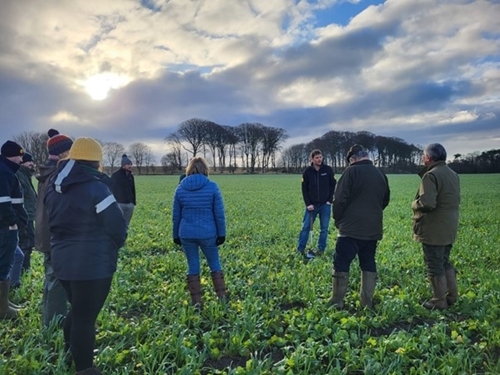Written by Fiona Torrance, Farmland Biodiversity Advisor for GWCT Scotland
A few weeks ago, 13 hardy souls defrosted their vehicles and headed to Gilston Farm for the latest PepsiCo FAB (Farming Arable Biodiversity) project farm walk. Gilston is one of six farms participating in the project and is located in Fife. Although the thermometers struggled to hit 0C, the group were warmly welcomed by farmer Matt Waldie and some much-appreciated hot drinks.
To kick the morning off, Matt was kind enough to give a presentation on the farm and some of measures for biodiversity the farm has been undertaking. This mainly focussed on cover crops, which the farm has been using for a number of years, as well as wild bird seed mixes, hedge management and pollinator mixes. After sufficient time for our toes to defrost, it was time to head outside and see these measures for ourselves.

Farmer Matt Waldie discussing cover crops. Credit: Fiona Torrance, GWCT
First stop was cover crops, and which led to a discussion on various mixes, sowing conditions and challenges that have been encountered. Although they are still learning how to overcome some of these issues, it was clear that Matt believes that this way of farming delivers for the farm, as well as biodiversity and the soil. Cover crops can be claimed back under the current AECS scheme in Scotland, although Matt plants additional areas that are utilised for their grazing benefits.
Next, we moved on to wild bird seed mixes. Although a bit too chilly for many birds to be out and about, we could see that most of the seed-producing species in the mix had been stripped of their crop. As farming becomes ever more efficient, there is less seed available for birds and other wildlife to feed on during the winter months and so habitat like this can be particularly important during the winter. At this point we were joined by a calling grey partridge in an adjoining field who seemed to agree with what we were discussing!
This naturally led on to subsequent discussions about the provision of supplementary feeding for farmland wildlife during the ‘hungry gap’. The period from December to March can be particularly crucial for farmland birds, with little seed on the ground or remaining plants. This year, project placement students, Bella and Rachael, will be conducting a study comparing different game bird feeder types and whether some are more or less attractive to non-target species as well as farmland birds. We look forward to sharing their results next year.
We were also fortunate to have Will Henderson and Geoff Coates from the Strathmore Wildlife Cluster join the meeting. This provided an excellent opportunity to compare the two cluster models; that of a traditional cluster linked geographically; and a producer cluster who are linked through a common commercial buyer. It was great to hear what the Strathmore Cluster (who have been running since 2018) had achieved since their inception, and also for the group to learn about some of the challenges they have had to overcome.
By this point we could barely feel our toes and were in need of something a little warmer, so the visit came to a close. These farm walks are important, not only for the group to learn what each other are doing, but also for building relationships and developing biodiversity outcomes that could attract funding support in the future. Although harvest this year has made visits a challenge, we hope to undertake these walks at all the farms participating in the project by the end of next year, which the team are very much looking forward to.